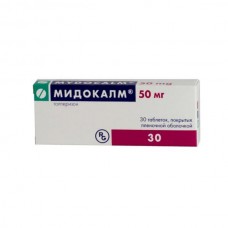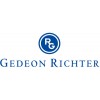Expiration date: 07/2028
The composition and form of issue:
Mydocalm
Tablets, film-coated. 1 tablet contains:
tolperizon (as hydrochloride) 50 mg
150 mg
excipients: citric acid monohydrate colloidal anhydrous silicone stearin talc microcrystalline starch, corn lactose monohydrate titanium dioxide macrogol 6000 hydroxypropyl methylcellulose 2910
blistere in 10 PCs., in box 3 blister.
Mydocalm-Richter
Solution for injection 1 amp. 1 ml contains:
tolperizon (as hydrochloride) 100 mg
lidocaine (as hydrochloride) 2.5 mg
excipients: methylparaben monoethylether the diethylene glycol water for injections
in dark glass vials at 1 ml box of 5 ampoules.
Description pharmaceutical form:
Mydocalm 50 mg: tablets, film-coated white color, round, lenticular, with a weak characteristic odor, engraved "50" on one side. In the cross-section are seen 2 layers.
Mydocalm 150 mg: tablets, film-coated white color, round, lenticular, with a characteristic odor, engraved "150" on one side. In the cross-section are seen 2 layers.
Mydocalm-Richter: colorless or slightly green solution with a characteristic smell, without mechanical impurities.
Feature:
A muscle relaxant of Central action.
Pharmacokinetics:
After ingestion well absorbed from the gastrointestinal tract. Cmax in the blood is reached after 0.5–1 h, bioavailability of approximately 20%. Metabolized in the liver and kidneys. The pharmacological activity of metabolites is unknown. Excreted by the kidneys as metabolites (more than 99%).
Description pharmacological action:
Has no membrane stabilizing and local anesthetic effect, reduces the pain sensitivity of peripheral nerve endings, inhibits the conduction of impulses in primary afferent and motor fibres, which leads to the blocking of mono - and polysynaptic spinal reflexes. Probably, again, due to the braking of receipt of Ca2+ in the presynaptic endings inhibits the release of neurotransmitters in the synapses. Promotes inhibition of excitation at reticulospinal way. Selectively reduces the activity of the caudal part of the reticular formation of the brain, reducing spasticity.
Reduces pathologically increased muscle tone and rigidity of muscles, reduces pain, facilitates arbitrary active movement. It has a weak and adrenoblokiruyuschim antispasmodic effects. Increases peripheral blood flow independently of the influence of the Central nervous system.
Indications:
- treatment of pathologically increased muscle tone and spasms of striated muscle due to organic diseases of the Central nervous system (including the defeat of the pyramidal paths, multiple sclerosis, stroke, myelopathy, encephalomyelitis)
- treatment of increased tone and muscle spasms, muscle contractures, accompanying diseases of the musculoskeletal system (including spondylosis, spondylosis, cervical and lumbar syndromes, arthrosis of large joints)
- rehabilitation treatment after orthopedic and traumatologic operations
- in a combination therapy of obliterating diseases of vessels (obliterative arteriosclerosis, diabetic angiopathy, thromboangiitis obliterans, Raynaud's disease), diseases arising from disorders of innervation of the vessels (acrocyanosis, intermittent angioneurotic dysbasia)
- specific pediatric indication is little's disease (infantile cerebral paralysis) and other encephalopathies accompanied by muscle dystonia — only for tablets.
Contraindications:
- hypersensitivity (including to lidocaine — for parenteral administration)
- myasthenia gravis
- children under 1 year of age (tablets), children's age (parenteral administration).
Application of pregnancy and breast-feeding:
During pregnancy (especially in I trimester) and breastfeeding treatment Midokalma is possible only if the expected benefit to the mother outweighs the potential risk to the fetus.
Side effects:
Muscle weakness, headache, reducing AD, nausea, vomiting, abdominal discomfort (dose reduction usually are). In rare cases, allergic reactions (skin itching, erythema, urticaria, angioedema, anaphylactic shock, shortness of breath, bronchospasm).
Drug interactions:
Can be used in combination with sedatives, hypnotics means and preparations containing alcohol. Not affect the effect of alcohol on the Central nervous system. Tolperison enhances the effect of niflumova acid (with simultaneous use may require dose reduction of niflumova acid). Funds for General anesthesia, peripheral muscle relaxants, psychotropic drugs, clonidine — enhance the effect tolperizona.
Method of application and dose:
Mydocalm
Inside, after eating, not liquid, squeezed small amounts of water. Adults — usually around 50 mg 2-3 times a day, gradually increasing the dose to 150 mg 2-3 times a day. Children at the age from 1 year to 6 years — a daily dose of 5 mg/kg, 7-14 years — 2-4 mg/kg (in 3 divided doses during the day). Tablet, film-coated, if the child is unable to swallow it, you can grind.
Mydocalm-Richter
For children important: use only tablets, film-coated, 50 mg.
In/m, adults — on 100 mg 2 times a day. In/in slowly, adults — 100 mg 1 time per day.
Overdose:
Mydocalm has a wide therapeutic range, the literature describes the use of the drug in children an oral dose of 600 mg in the absence of serious toxic symptoms. If ingestion is 300-600 mg per day in patients in childhood in some cases observed irritability.
In the study of acute oral toxicity in animal experiments high doses caused ataxia, tonic and clonic convulsions, shortness of breath and respiratory paralysis.
Treatment: gastric lavage (if oral), symptomatic and supportive therapy. There is no specific antidote.
Precautions:
Apply strictly on doctor's prescription in order to avoid complications.
Mydocalm does not affect the ability to drive and perform work associated with increased risk.




